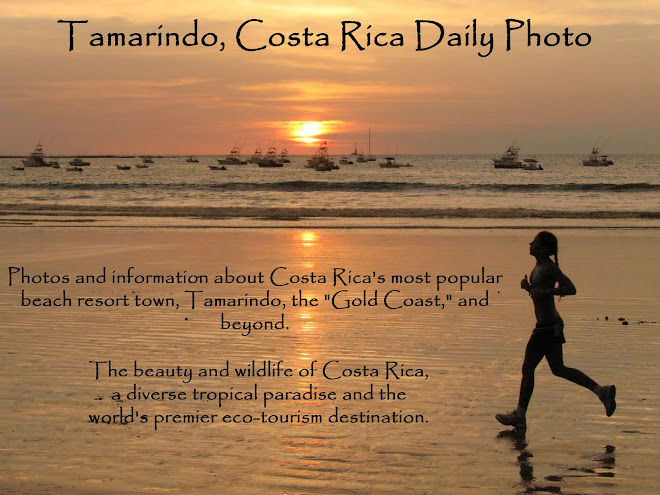
The first-of-the-month Daily Photo Theme Day is to show the Sister City for each community, except for cities that do not have one, in which case the Daily Photo
bloggers can recommend one. My recommendation for a sister city for
Tamarindo is
Laguna Beach, California, shown above.
Here are the reasons for my recommendation. My criteria were to find a community that shares many of Tamarindo's features, such as places that are:
- A beach resort
- Known for excellent surfing
- Great restaurants
- Upscale, but still a little "funky"
- Cosmopolitan
- Not too large a town
- Natural beauty of its location
Laguna Beach fills all of the above criteria. It is a beach resort in Orange County, California, 80 km (50 mi.) south of Los Angeles, between Newport Beach and San Juan Capistrano. It has excellent surfing and picturesque coves and beaches. It has superb restaurants and quaint shops. It is known as an arts community, as it has many art galleries and each summer is the site of several major art exhibitions and the Pageant of the Masters.
I mentioned that I felt that to be a sister city to
Tamarindo a resort town should have a funky side. After all,
Tamarindo is in the process of transitioning from a modest fishing and surfing town into an international resort.
The
Laguna Beach area also has remnants from an earlier day. Just north of town is Crystal Cove. Many years ago farm workers and others built little beach cottages from scrap lumber and were allowed to live there even after the State acquired the land. At the end of the 1990's, they lost an 18-year legal battle by the State of California to evict them from their houses. The State Park Service has renovated and makes available for rent, at very reasonable prices, some of the cottages that remain on the beach, which can be seen in my photo below.

Laguna Beach has a much greater reputation for the arts, but the arts are also present in Tamarindo, as I will show and explain and in some photos and posts during the coming days and weeks. (In fact, tomorrow I will show you an extraordinary and famous masterpiece of art that can be seen in Tamarindo in a way unique to all of the Spanish-speaking countries in Latin America.)
Laguna Beach's Pageant of the Masters is hard to explain. It is a nightly show in an outdoor amphitheater that seats more than 2,000 people, and on several stages models (who are community volunteers) recreate famous works of art. For example, every year the finale is to have 13 people sitting at a table dressed exactly like Leonardo da Vinci's painting of the Last Supper, with the table, background, costumes and makeup exactly like the painting. They show a different work of art (paintings and sculpture) every 90 seconds, accompanied by a live orchestra.
I know Laguna Beach well, as my parents lived nearby before they passed away a few years ago. My wife and I spend time there each summer. Laguna Beach would be a splendid "sister city" for Tamarindo. I should add a qualification, however. Tamarindo is not incorporated as its own town. It is governed by the city government of Santa Cruz, which is about 20 minutes away.
 (OK, I know this write-up is a presumptuous stretch.) Monet portrayed the beauty he found in the play of light on the front of the Rouen Cathedral and stacks of hay in the fields. For Van Gogh, a vase with sunflowers sufficed as a vehicle for his artistic expression. For Andy Warhol, a Campbell's Tomato Soup can became an artistic masterpiece. We find art in what we see.
(OK, I know this write-up is a presumptuous stretch.) Monet portrayed the beauty he found in the play of light on the front of the Rouen Cathedral and stacks of hay in the fields. For Van Gogh, a vase with sunflowers sufficed as a vehicle for his artistic expression. For Andy Warhol, a Campbell's Tomato Soup can became an artistic masterpiece. We find art in what we see.


+0585+P01000975.jpg)


+IMG_0783.jpg)
++0568+P1000941.jpg)

+IMG_2788.jpg)


.JPG)

+IMG_2969.jpg)
+IMG_2964.jpg)









+Jungle_Toucans%5B1%5D.jpg)

+0312+P1000395.jpg)
+IMG_3381.jpg)





+IMG_3197.jpg)





++IMG_3127.jpg)







